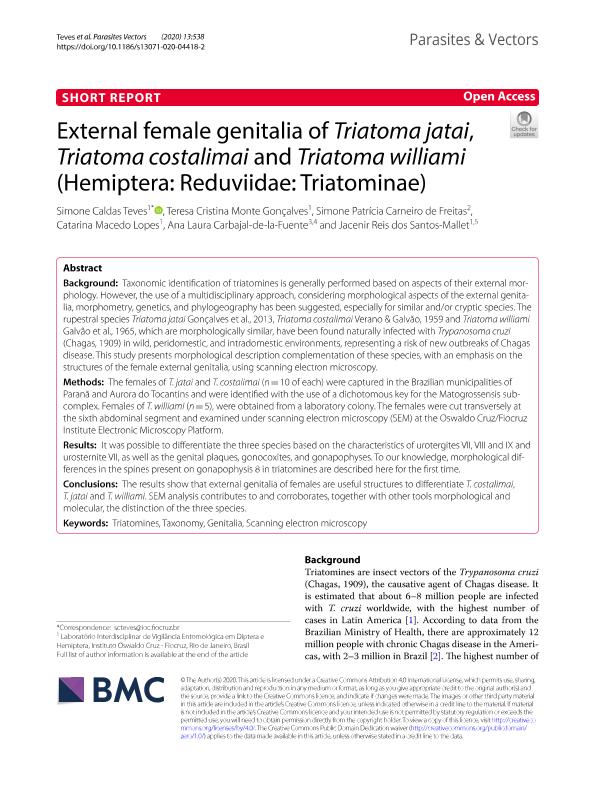Mostrar el registro sencillo del ítem
dc.contributor.author
Caldas Teves, Simone
dc.contributor.author
Monte Gonçalves, Teresa Cristina
dc.contributor.author
Carneiro de Freitas, Simone Patrícia
dc.contributor.author
Macedo Lopes, Catarina
dc.contributor.author
Carbajal de la Fuente, Ana Laura

dc.contributor.author
Reis dos Santos Mallet, Jacenir
dc.date.available
2023-08-08T15:42:48Z
dc.date.issued
2020-11
dc.identifier.citation
Caldas Teves, Simone; Monte Gonçalves, Teresa Cristina; Carneiro de Freitas, Simone Patrícia; Macedo Lopes, Catarina; Carbajal de la Fuente, Ana Laura; et al.; External female genitalia of Triatoma jatai, Triatoma costalimai and Triatoma williami (Hemiptera: Reduviidae: Triatominae); BioMed Central; Parasites and Vectors; 13; 1; 11-2020; 1-6
dc.identifier.issn
1756-3305
dc.identifier.uri
http://hdl.handle.net/11336/207404
dc.description.abstract
Background: Taxonomic identification of triatomines is generally performed based on aspects of their external morphology. However, the use of a multidisciplinary approach, considering morphological aspects of the external genitalia, morphometry, genetics, and phylogeography has been suggested, especially for similar and/or cryptic species. The rupestral species Triatoma jatai Gonçalves et al., 2013, Triatoma costalimai Verano & Galvão, 1959 and Triatoma williami Galvão et al., 1965, which are morphologically similar, have been found naturally infected with Trypanosoma cruzi (Chagas, 1909) in wild, peridomestic, and intradomestic environments, representing a risk of new outbreaks of Chagas disease. This study presents morphological description complementation of these species, with an emphasis on the structures of the female external genitalia, using scanning electron microscopy. Methods: The females of T. jatai and T. costalimai (n = 10 of each) were captured in the Brazilian municipalities of Paranã and Aurora do Tocantins and were identified with the use of a dichotomous key for the Matogrossensis subcomplex. Females of T. williami (n = 5), were obtained from a laboratory colony. The females were cut transversely at the sixth abdominal segment and examined under scanning electron microscopy (SEM) at the Oswaldo Cruz/Fiocruz Institute Electronic Microscopy Platform. Results: It was possible to differentiate the three species based on the characteristics of urotergites VII, VIII and IX and urosternite VII, as well as the genital plaques, gonocoxites, and gonapophyses. To our knowledge, morphological differences in the spines present on gonapophysis 8 in triatomines are described here for the first time. Conclusions: The results show that external genitalia of females are useful structures to differentiate T. costalimai, T. jatai and T. williami. SEM analysis contributes to and corroborates, together with other tools morphological and molecular, the distinction of the three species.
dc.format
application/pdf
dc.language.iso
eng
dc.publisher
BioMed Central

dc.rights
info:eu-repo/semantics/openAccess
dc.rights.uri
https://creativecommons.org/licenses/by/2.5/ar/
dc.subject
GENITALIA
dc.subject
SCANNING ELECTRON MICROSCOPY
dc.subject
TAXONOMY
dc.subject
TRIATOMINES
dc.subject.classification
Zoología, Ornitología, Entomología, Etología

dc.subject.classification
Ciencias Biológicas

dc.subject.classification
CIENCIAS NATURALES Y EXACTAS

dc.title
External female genitalia of Triatoma jatai, Triatoma costalimai and Triatoma williami (Hemiptera: Reduviidae: Triatominae)
dc.type
info:eu-repo/semantics/article
dc.type
info:ar-repo/semantics/artículo
dc.type
info:eu-repo/semantics/publishedVersion
dc.date.updated
2023-08-08T13:00:19Z
dc.journal.volume
13
dc.journal.number
1
dc.journal.pagination
1-6
dc.journal.pais
Reino Unido

dc.journal.ciudad
Londres
dc.description.fil
Fil: Caldas Teves, Simone. Instituto Oswaldo Cruz; Brasil
dc.description.fil
Fil: Monte Gonçalves, Teresa Cristina. Instituto Oswaldo Cruz; Brasil
dc.description.fil
Fil: Carneiro de Freitas, Simone Patrícia. Instituto Oswaldo Cruz; Brasil
dc.description.fil
Fil: Macedo Lopes, Catarina. Instituto Oswaldo Cruz; Brasil
dc.description.fil
Fil: Carbajal de la Fuente, Ana Laura. Dirección Nacional de Institutos de Investigación. Administración Nacional de Laboratorios e Institutos de Salud. Centro Nacional de Diagnóstico e Investigaciones Endemo-epidémicas; Argentina. Consejo Nacional de Investigaciones Científicas y Técnicas; Argentina
dc.description.fil
Fil: Reis dos Santos Mallet, Jacenir. Instituto Oswaldo Cruz; Brasil
dc.journal.title
Parasites and Vectors

dc.relation.alternativeid
info:eu-repo/semantics/altIdentifier/doi/https://doi.org/10.1186/s13071-020-04418-2
Archivos asociados
